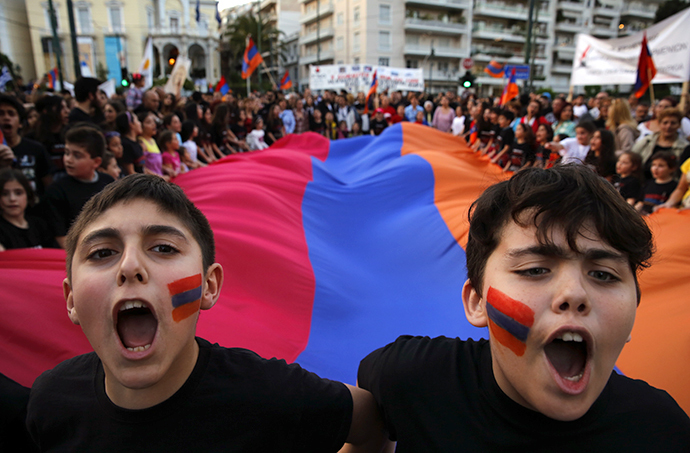
Armenia Facing Demographic Collapse
Publication: Eurasia Daily Monitor Volume: 12 Issue: 224
By:

“ ‘All progressive humanity’ is concerned by the periodic reports about the disappearance of this or that type of plant or animal, [but] we are much less concerned about the disappearance of nations and nationalities,” Armenian expert Gevork Pogosyan says. Yet, as the post-Soviet period demonstrates, that can happen even to larger nations that have lost population numbers as a result of declining birthrates and increasing outmigration and assimilation (see EDM, December 11). One such country now facing a demographic collapse is Armenia, whose population has dropped by nearly 1.5 million since 1991 and is projected to decline by that much again over the next several decades (Kavkazoved.info, December 6).
Such declines call into question the long-term survival of Armenians as a nation, the director of the Yerevan Institute of Philosophy, Sociology and Law suggests. But more immediately, they have significant security implications given that those leaving Armenia are the most educated portion of the population rather than the working class. And furthermore, Armenia remains locked in a conflict with its neighbor, Azerbaijan, over Karabakh and the other Armenian-occupied territories of Azerbaijan. But like the other Muslim republics of the former Soviet space, Azerbaijan is experiencing rapid population growth and is predicted to continue to do so for some time to come.
Between 1920 and 1991, Pogosyan says, Armenia’s population rose from 880,000 to approximately five million; but after 1991, it began to lose population and will continue to do so. In part, this reflects the decline in the birthrate by 50 percent over that period; but to a greater extent, it is the product of outmigration, something many Armenians thought might be temporary but which is proving to be permanent. “Hundreds of thousands have left, but only a handful have returned,” Pogosyan notes. And because it is the young who are leaving most often, the number of women in prime childbearing age groups is falling, which will push the population down even more, perhaps to only 1.5 million by mid-century. Moreover, that population will be far “grayer” than the current one.
Some of this reflects the real absence of opportunities in Armenia, the Yerevan scholar argues. But part of it signifies a spiritual crisis in which Armenians increasingly feel that they and their children have no future in a country that is locked in what appears to be a permanent, if undeclared, war and whose government has done little to fight domestic corruption or crime. The authorities, meanwhile, have often reacted with indifference to this trend or even welcomed it: One former prime minister said that if Armenians were not leaving the country in massive numbers, there would be a revolt at home.
If the problem is to be addressed, Pogosyan says, the government must first admit that the problem exists, something it has not been willing to do; and it must then adopt policies intended to change the existing national psychology. At the same time, it must recognize that some of the things it is doing to save the Armenian economy may be destroying the country’s demographic future. Entering the Eurasian Economic Union, for example, will make it even easier for Armenians to leave their country and never return. It is already the case, he says, that there are almost as many ethnic Armenians in Russia as there are in Armenia.
Moreover, he continues, it is not just a question of gross numbers. If many international guest workers from Muslim republics are low-skilled people, between 55 and 60 percent of Armenians leaving to work elsewhere are highly trained professionals. That further depresses the future of Armenia. And this trend gives no sign of easing. According to research his institute has done, Pogosyan says, “up to 40 percent of young people are set on leaving the country, either to study, for to work, or to live there and marry. This is a very bad symptom.”
Yerevan cannot hope to stop outmigration, Pogosyan asserts, but what it must do if the nation is to have a future is to promote “circular migration,” in which Armenians go abroad for part of their lives and then return to Armenia. That is the pattern in Europe, and Yerevan must take steps to make it the pattern in Armenia as well. At the same time, it must do more to attract Armenians from the eight-million-strong Armenian diaspora. To date, however, Yerevan has not been doing that. For example, he says, it has taken in only 7,000 Armenians from Syria out of an Armenian community there of 150,000.
But the situation is even worse than those figures suggest, Pogosyan states, because many of the Syrian Armenians who have come to Armenia are using it as a way station until they can move to Europe or the United States. He says he has a neighbor from Syria, a doctor with his own clinic in Armenia. But now that neighbor is selling his clinic and apartment and planning to move to France. He and his family “lived in Armenia only a year, and you already cannot keep him” there. “That is the reality” of Armenian life now; as a result, the scholar says, “depopulation continues.”




